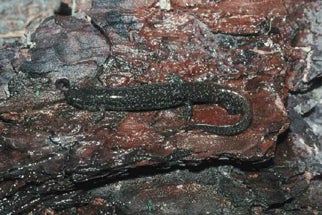SCIENTIFIC NAME:
Desmognathus auriculatus (Holbrook)
OTHER NAMES:
None.
STATUS:
Rapidly declining and possibly endangered due to unknown causes. In Alabama, known only from a few localities in southernmost tier of counties where it occurs in mucky areas in gum swamps, sphagnum bogs, and forested sluggish stream floodplains. HIGHEST CONSERVATION CONCERN.
DESCRIPTION:
A four-legged salamander up to about 12 centimeters (five inches) long, with hind legs noticeably stouter than forelegs, and often with a patch of light brown to reddish pigment reaching from base of eye backward to corner of mouth. Ground color dark brown to black; sides often flecked with white. Belly diagnostically coal black, but peppered with small white or silvery flecks. Two rows of small round light spots usually evident along upper and lower sides between front and hind legs; both rows commonly continuing onto the tail. These spots and a lighter stripe down the tail crest often reddish in color. Tail cross-section progressively bladelike toward tip. Tail cross-section and predominantly black venter with white flecks are best external characters for distinguishing species from closely related spotted dusky salamander, with which it is most likely to be confused (Means 1999). Short-lived larva (seven months) tiny (to 13 mm [1/2 in.] long) with bushy black external gills.
DISTRIBUTION:
Lower Coastal Plain of southeastern United States from eastern Texas to North Carolina. Known only from a few localities in southern Alabama, possibly including Houston, Geneva, Covington, Escambia, Baldwin, and Mobile Counties (Means 1974, 1999).
HABITAT:
Swampy, mucky, wet places in floodplain sloughs and swales of rivers and larger streams, and sometimes along swampy lake and pond margins (Means 2000). Found under logs and decomposing leaf litter at edge of water in peaty, mucky spots. When exposed, wriggles vigorously to escape into water or down into peat via crayfish burrows. During low water stages and drought follows water table down into peat. The mucky margins of Lake Jackson at Florala were good habitat in the 1970s, but unknown whether species is currently extant there. Larvae found in shallow water along edges of swamps and sloughs and along slow moving streams. In Alabama,does not occur in first- and second-order ravine streams where other species of Desmognathus are found.
LIFE HISTORY AND ECOLOGY:
Because this species has been confused with similar members of its genus, little has been published on its life history and ecology (Means 1974). In September, females lay one cluster of about six to 20 eggs under logs and debris in moist soil at, or near, the edge of water and remain with eggs until they hatch in October or November. Larvae remain aquatic until about April, at which time they metamorphose into tiny miniatures of adults. Age at maturity is probably at least three years. In good habitat is always the most abundant salamander found, but because it lives at the edge of water with lots of soggy organic debris, biologists often overlook it. Prey have not been determined, but probably eats terrestrial invertebrates found in wet leaf litter including earthworms, ground beetles, dipterans, springtails, and amphipods. Predators probably are large amphiumas, watersnakes, garter snakes, the mud turtle, and common snapping turtle. Most common habitat associates are the mud salamanderand the one-toed amphiuma,whose preferences for mucky and peaty habitats overlap those of the southern dusky salamander (Means 2000).
BASIS FOR STATUS CLASSIFICATION:
Poorly known until the 1970s because of the confusing external similarityamong sympatricdusky salamanders, andthe southern dusky salamander’spreference for mucky, peaty habitats (Means 1974). Thereafter, known populations in nearby Florida began to disappear (Dodd 1998) and by the late 1990s, the species had declined throughout its distribution. In the adjacent Florida Panhandle, a search of more than 75 relatively pristine localities, in which the species formerly occurred as the most abundant salamander, failed to find any (Means and Travis 2003). Only one Alabama specimen has been collected in the past 25 years. In addition to an unknown cause for its distribution-wide decline, and because its swampy habitats are threatened by impoundment, drainage, and increasing chemical and sediment pollution from agricultural, silvicultural, urban, and suburban runoff, this species may already have been extirpated from Alabama and has almost certainly achieved imperiled status.
Author: D. Bruce Means






